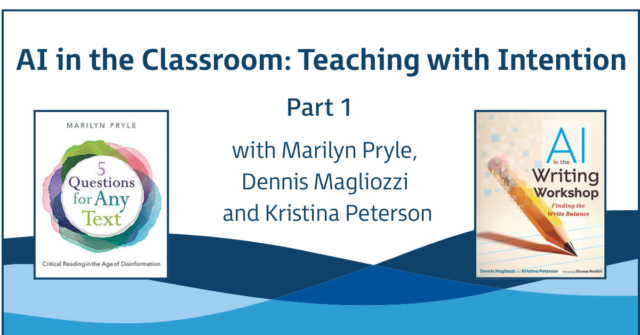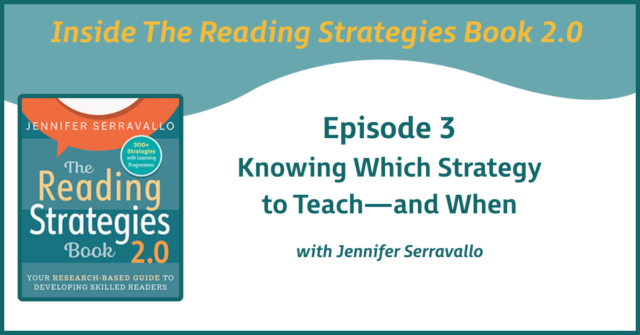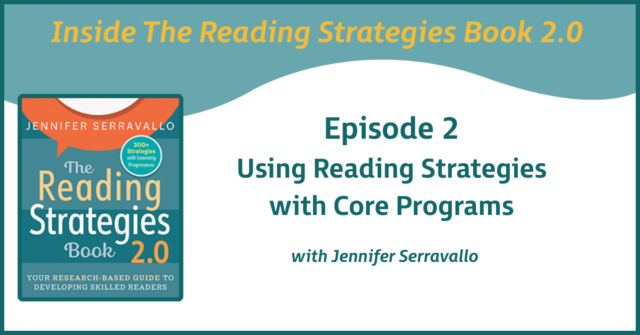
Now more than ever, students need the skills to critically think about the texts they encounter. Today we have Marilyn Pryle on the podcast. Her newest book, 5 Questions for Any Text: Critical Reading in the Age of Disinformation, provides a simple framework for improving students' critical reading skills by encouraging the development of original thoughts and responses to texts.
Today, she explains how a simple question, "How am I reacting?", can empower students to recognize their feelings and think more critically, whether they're reading a novel or scrolling through social media.
Transcript
Marilyn Pryle:
In reality, what happens, especially outside the classroom, students are encountering texts in all forms, video, print, everything, emojis. It's just this flood of information and it is eliciting emotion in them within the first two seconds. To push aside feelings and emotions in the classroom in favor of analysis, I think, is a disservice, because what you're feeling when you consume a text is affecting how the information gets to your brain.
If we don't teach students to recognize that and pause and think, "Okay, I'm reacting this way, what do I want to do with that?", instead of just consuming and reacting, consuming and reacting.
Edie:
I would like to get into how you prompt that in your classroom, how you prompt, and then how you really even push the thinking further.
Marilyn:
The new book is about the five questions to make students stronger, critical readers. Question number one is, "What am I reading?" And then, "What is it showing me? What is it hiding?". And then there's a question in there that says, "How am I reacting?" And then of course, the fifth question is, "How does it work?", meaning that craft aspect.
What I'm trying to do is position this question of, "How am I reacting to the text?", as one of the vital components for encountering a text. With the reading response method, students have categories that they can choose from. After they read a text, they consult all of these categories and decide, how do I want to respond? And it might be in that emotional way. Do I want to pause? Do I want to look at my emotions? I recognize that I'm feeling something. Do I want to check in with myself and name it?
Just creating that space as a category to choose from shows students that, number one, that space exists and it's always available for you to step into. You might not choose it right now, but it's always there. And number two, it teaches them if they do choose that path, if they choose that category to respond, they are practicing how to name their emotions. And research shows that even just naming your emotions makes your response clearer, if you recognize how you're reacting to a text.
In that way, students in my class all year, every text, have that choice of spaces to step into. And many of them do. They love those categories. Categories like recognizing my reaction, or holding up a mirror is a great one that I love, or appreciating beauty. Underneath this question of, how am I reacting, there are about seven or eight categories.
Again, I wanted to give space for just recognizing my reaction. What am I feeling? How is it affecting me? How do I want to respond? But then also with a category like appreciating beauty, I want it to create space for an emotion like awe. It doesn't all have to be negative. It can be, I'm feeling something really positive here.
For a category like holding up a mirror, the prompt asks the student, "Do you feel like this text is positioning you as an insider or an outsider to the text?" And that's really powerful too. So, teaching the students to pause and ask, "What is this text doing? What is it trying to evoke in me?" And I'll give you a couple examples for that...
Edie:
Yeah, great.
Marilyn:
... holding up a mirror one, because I love it so much. I had one student, was reading a book. The student herself identifies as biracial, and the book had a biracial main character, and the character was talking about her hair and all the trials she goes through with it. My student had written about, "This is exactly what I go through, so I feel like I am an insider to this text.", when she went on with that in the reading response. That was really gratifying to read that.
Another student was reading one of the books from the Heartstopper series. This other student also identified as queer. When she read about that main character, she said, "This character's coming-out process was different from my own coming-out process." She said, "I feel like an insider, but also a little bit of an outsider, because I didn't have the same experience that the character did."
Giving students that space to step into and really to check in with themselves and to see, "All right, this is what's happening in the text, but what is it evoking in me?", it empowers the students and then it helps them become more critical.
Edie:
What I think comes across in your book is that it gives you such a powerful dialogue with the students, because you do a lot of responding to their initial responses, and you see the thinking. Or at least what I saw, was the conversation between you and the student and the thinking: Grow and get pushed.
Marilyn:
Exactly. I talk with them about their reading responses almost every day or every other day, depending on how long it takes me to get around the room. But those discussions are very authentic, whatever a student has said. Even if they just do a response on recognizing my reaction, "I noticed that I felt really angry when I read this.", et cetera, and they go on, sharing that with me in class is an act of trust.
Every small conversation that we have, and I respond to them, it builds the overall cultural trust in the classroom. It lets me interact with the students. It gives me a barometer of where they are, what they're thinking, what they're understanding. There's a category called, Informed Inquiry. Maybe they're reading something and they just feel confused and they stop and think, "Okay, I'm confused.", and instead of just getting angry about that, they think, "What am I confused about? Where can I pinpoint a question?"
And then they ask that, and that gives me the chance to even discuss that with them and help them.
Edie:
The emotion as an entry point, you then do move into a lot of critical analysis...
Marilyn:
Right.
Edie:
... and some of the other components of interacting with any text in the world.
Marilyn:
Absolutely, right. I love talking about when students write, "Appreciating beauty", and they choose that one a lot, that category.
Edie:
Interesting.
Marilyn:
A lot of times what they zero in on is something about the craft, to your point. They're appreciating the beauty of the text and they're noticing something within the craft, whether it's the description, whether... I've got an example in the book where a middle school student points out the placement of a period at the end of a sentence and what it does and what it evokes. It's just awesome. So, then I can have that whole discussion with them-
Edie:
Great.
Marilyn:
... about that. So it's true, these feelings discussions very quickly lead into discussions of craft or sometimes larger discussions.
One of the categories is, Taking Action. I felt like students, when they feel anger, when they feel discouraged, emotions like that, I didn't want them to feel hopeless. So, I created a category, created a space where they could think to themselves, "Okay, I'm upset about this. I'm upset about this issue. What can I do? What would be one step that I could do?" Not that you have to do it, but, "What could I do to learn more or to act against this in some way, or to advocate for something?"
When they write that too, we can talk about some of the larger issues, right?
Edie:
Yeah.
Marilyn:
So, it's always a range. I never know what I'm going to talk to a student about when I approach their desk, but then when I see their reading response, I see the directions we can go. And then depending on the student themselves, I know what they'd be comfortable with talking about or not, and we just go from there. So, it's always interesting, it's always new, and it's always based in the text.
Edie:
Both of the examples that you just gave with emotional reactions, I think were both students interacting with a book?
Marilyn:
Yes.
Edie:
Another thing I find really important to the book is that you have a lot of examples that are not books, that are advertisements.
Marilyn:
Mm-hmm.
Edie:
I think moving into emotional reactions to a greater definition of a text, and media especially, that are really critical skills for young people. Could you go a little bit into some of those?
Marilyn:
Our classrooms are so contained, and when we try to teach students about media literacy, we always identify the genre and we tell them exactly what we want them to do, like, "Take a look at this article and see if you can identify some of the unreliable sources.", for example. Right?
Edie:
Yeah.
Marilyn:
But outside school, in the world, everything's just hitting them. No one's compartmentalizing it for them, no one's giving them specific directions. Helping them ask these questions inside school, so that when they get outside school, they can ask themselves the questions again, like, "Wait, is this a reliable source?", or with the case of emotions, "What am I feeling? Is this commercial trying to make me feel something? Is this video on Instagram? Is this influencer trying to make me feel something?"
That's what I'm after. With all of the five questions, by having them practice it day after day in class, I'm hoping it just becomes a habit in their brain, so when they get outside school and they see something... Question number one is, "What am I reading?" That applies to any text. "What am I looking at? What am I listening to?"
I find that, again, as teachers, we always identify the genre for students, which I feel is a disservice because our concepts of genre are being used against us in the outside world. You think you're looking at a news article, and you get to the bottom and it wasn't that at all. It was...
Edie:
Right.
Marilyn:
... just a politically-biased piece. Or you think you're looking at just an influencer telling you something, but at the end, you realize it was just an advertisement...
Edie:
Right.
Marilyn:
... the whole time. So, genre is deliberately being muddied. Sometimes I'll have the students bring in texts just from their own outside viewing and reading and watching and listening, and we'll do discussions about that in class.
One student wrote a reading response about the website, Athleta, and how she noticed... One of the categories that the students have is, Special Effects. She pulled out some of the special effects that were going on on the website, and pinpointed what those effects were designed to do. Basically, it was trying to get her to engage in the sale. Right?
Edie:
Yeah, yeah.
Marilyn:
She recognized that and wrote it out. For us as adults, that might seem obvious, but I don't think it's obvious for the students, or they get used to it, but having them unpack it and see what's really going on.
Another student did a similar thing with Rare Beauty, which is Selena Gomez's website of [inaudible 00:12:23] makeup. The student just took a deeper dive of what is the motivation here behind this, what's happening, and she appreciated Gomez's efforts at this natural beauty standard. But just again, getting students... Instead of just consuming, consuming, consuming, without questioning, helping them unpack a little bit of what they're seeing. And then when they go outside of school, hopefully it's just in their brain.
When they see a commercial, for example, and they feel sad or they feel angry, hopefully since they've been practicing it in class, they can say, "Wait, I'm feeling something. What is it? And why?", and then that takes them into craft a little bit too. But, it's all about the habit of it.
Edie:
Thanks for tuning in today. If this piqued your interest and you'd like to learn more about Marilyn's Five Questions, she's offering a three-part series. Learn more about this and read a full transcript at blog.heinemann.com.
About the Author

Marilyn Pryle (@MPryle) is an English teacher at Abbington Heights High School in Clarks Summit, PA and has taught middle and high school English for over twenty years. She is the author of several books about teaching reading and writing, including 50 Common Core Reading Response Activities and Writing Workshop in Middle School. Learn more about Marilyn at marilynpryle.com.




